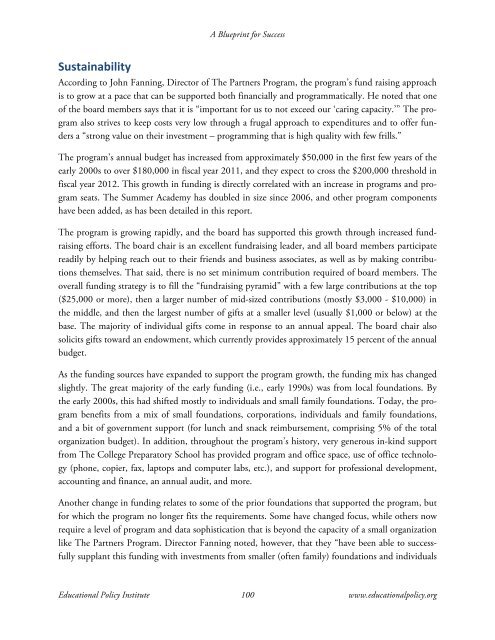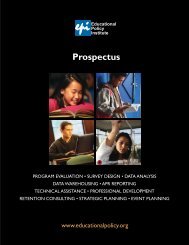A BluePrint for Success: Case Studies of Successful - Educational ...
A BluePrint for Success: Case Studies of Successful - Educational ...
A BluePrint for Success: Case Studies of Successful - Educational ...
You also want an ePaper? Increase the reach of your titles
YUMPU automatically turns print PDFs into web optimized ePapers that Google loves.
Sustainability<br />
A Blueprint <strong>for</strong> <strong>Success</strong><br />
According to John Fanning, Director <strong>of</strong> The Partners Program, the program’s fund raising approach<br />
is to grow at a pace that can be supported both financially and programmatically. He noted that one<br />
<strong>of</strong> the board members says that it is “important <strong>for</strong> us to not exceed our ‘caring capacity.’” The program<br />
also strives to keep costs very low through a frugal approach to expenditures and to <strong>of</strong>fer funders<br />
a “strong value on their investment – programming that is high quality with few frills.”<br />
The program’s annual budget has increased from approximately $50,000 in the first few years <strong>of</strong> the<br />
early 2000s to over $180,000 in fiscal year 2011, and they expect to cross the $200,000 threshold in<br />
fiscal year 2012. This growth in funding is directly correlated with an increase in programs and program<br />
seats. The Summer Academy has doubled in size since 2006, and other program components<br />
have been added, as has been detailed in this report.<br />
The program is growing rapidly, and the board has supported this growth through increased fundraising<br />
ef<strong>for</strong>ts. The board chair is an excellent fundraising leader, and all board members participate<br />
readily by helping reach out to their friends and business associates, as well as by making contributions<br />
themselves. That said, there is no set minimum contribution required <strong>of</strong> board members. The<br />
overall funding strategy is to fill the “fundraising pyramid” with a few large contributions at the top<br />
($25,000 or more), then a larger number <strong>of</strong> mid-sized contributions (mostly $3,000 - $10,000) in<br />
the middle, and then the largest number <strong>of</strong> gifts at a smaller level (usually $1,000 or below) at the<br />
base. The majority <strong>of</strong> individual gifts come in response to an annual appeal. The board chair also<br />
solicits gifts toward an endowment, which currently provides approximately 15 percent <strong>of</strong> the annual<br />
budget.<br />
As the funding sources have expanded to support the program growth, the funding mix has changed<br />
slightly. The great majority <strong>of</strong> the early funding (i.e., early 1990s) was from local foundations. By<br />
the early 2000s, this had shifted mostly to individuals and small family foundations. Today, the program<br />
benefits from a mix <strong>of</strong> small foundations, corporations, individuals and family foundations,<br />
and a bit <strong>of</strong> government support (<strong>for</strong> lunch and snack reimbursement, comprising 5% <strong>of</strong> the total<br />
organization budget). In addition, throughout the program’s history, very generous in-kind support<br />
from The College Preparatory School has provided program and <strong>of</strong>fice space, use <strong>of</strong> <strong>of</strong>fice technology<br />
(phone, copier, fax, laptops and computer labs, etc.), and support <strong>for</strong> pr<strong>of</strong>essional development,<br />
accounting and finance, an annual audit, and more.<br />
Another change in funding relates to some <strong>of</strong> the prior foundations that supported the program, but<br />
<strong>for</strong> which the program no longer fits the requirements. Some have changed focus, while others now<br />
require a level <strong>of</strong> program and data sophistication that is beyond the capacity <strong>of</strong> a small organization<br />
like The Partners Program. Director Fanning noted, however, that they “have been able to successfully<br />
supplant this funding with investments from smaller (<strong>of</strong>ten family) foundations and individuals<br />
<strong>Educational</strong> Policy Institute 100 www.educationalpolicy.org




